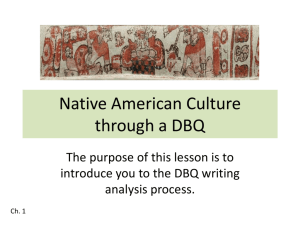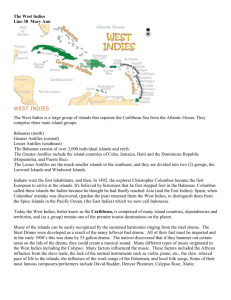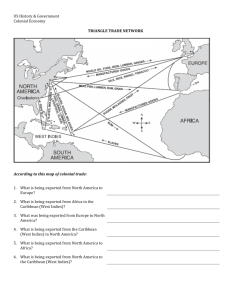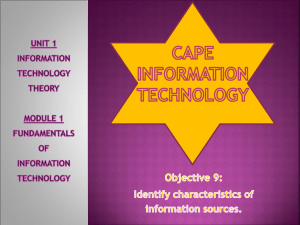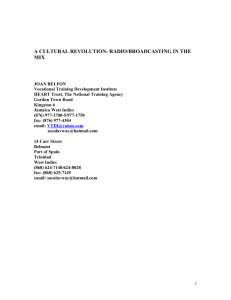Conference Paper - Inter
advertisement
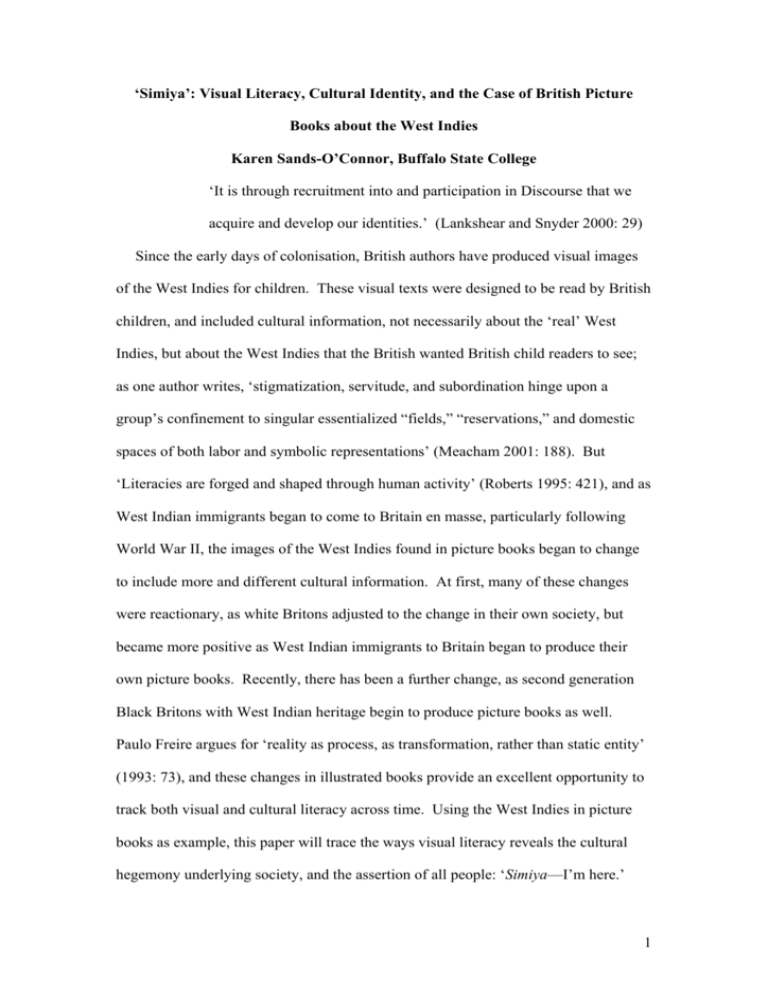
‘Simiya’: Visual Literacy, Cultural Identity, and the Case of British Picture Books about the West Indies Karen Sands-O’Connor, Buffalo State College ‘It is through recruitment into and participation in Discourse that we acquire and develop our identities.’ (Lankshear and Snyder 2000: 29) Since the early days of colonisation, British authors have produced visual images of the West Indies for children. These visual texts were designed to be read by British children, and included cultural information, not necessarily about the ‘real’ West Indies, but about the West Indies that the British wanted British child readers to see; as one author writes, ‘stigmatization, servitude, and subordination hinge upon a group’s confinement to singular essentialized “fields,” “reservations,” and domestic spaces of both labor and symbolic representations’ (Meacham 2001: 188). But ‘Literacies are forged and shaped through human activity’ (Roberts 1995: 421), and as West Indian immigrants began to come to Britain en masse, particularly following World War II, the images of the West Indies found in picture books began to change to include more and different cultural information. At first, many of these changes were reactionary, as white Britons adjusted to the change in their own society, but became more positive as West Indian immigrants to Britain began to produce their own picture books. Recently, there has been a further change, as second generation Black Britons with West Indian heritage begin to produce picture books as well. Paulo Freire argues for ‘reality as process, as transformation, rather than static entity’ (1993: 73), and these changes in illustrated books provide an excellent opportunity to track both visual and cultural literacy across time. Using the West Indies in picture books as example, this paper will trace the ways visual literacy reveals the cultural hegemony underlying society, and the assertion of all people: ‘Simiya—I’m here.’ 1 Visual literacy in picture books has specific meaning. Because of the connection between reading and being educated, picture books have always been seen by educators as mediations. Pictures are, in essence, serving text in that they help text make more sense to readers. Nodelman writes that, ‘The early use of pictures for their informational value obviously relates to the longstanding conviction that books for children should have a primarily educational purpose’ (1988: 3). This statement implies, however, that pictures have an informational value that is somehow ‘true’ or ‘real’, an assumption not quite so obvious. Nodelman goes on to say that ‘Some of the more obvious narrative information implied by the objects in pictures relates to our most basic cultural assumptions’ (1988: 111); I would argue rather that narrative information is not just reinforced by cultural assumptions, but in fact the visual symbols and absences actually creates cultural assumptions for readers unfamiliar with the visual text’s subjects. Readers of British children’s literature about the West Indies were and are primarily ignorant of the ‘real’ West Indies, and thus picture books often create the first and only images that child readers have of the region throughout their childhood. Most early British books for children contained few illustrations. Illustrations were expensive to reproduce, and only certain classes of children had time and leisure to read. Illustrated books about the West Indies were even rarer, because few authors had traveled beyond the confines of Great Britain. Early children’s books relied on written accounts, such as Columbus’s journals and the descriptions of sugar plantation owners like Bryan Edwards. Maps were the primary visual reference to the land in these books, because the image of a map allowed for, as Klinghoffer suggests, ‘States [to] engage in ‘power projection’ overseas, seeking colonies, bases, and logistical rights. . . . Blank space in an area implied that territorial claims could be made there” 2 (2006: 78-79). A map of the West Indies for young people provided a literal ‘road map’ for the direction of Empire and imperial progression. Maps provide a particular kind of visual literacy. Although they are drawn or engraved, they rely heavily on the written context in which they are set. As Mignolo points out, ‘The control of the cultural sphere is similar in many ways to maps. It gives the impression that it covers the territory, disguised under a set of principles that allowed for certain expressions to be ignored . . . because they were disturbing’ (2003: 297). A map of the West Indies suggests containment, through its latitude and longitude lines, as well as significance; most maps from the early 1800s, for example, show place names for islands and for cities, but not for mountain ranges, indicating the value placed on the concept of civilization. A map can also refer to what is outside of the boundaries in a significant way; a reference to London or England, for example, often shifts the central focus of the map offstage, as it were, and suggests that the islands of the West Indies only exist in reference to Great Britain. The other early depictions of the West Indies came through the popular press, particularly from chapbooks and theatre productions. Reproductions of theatrical works in toy theatres and depictions in chapbooks were both heavily influenced by Defoe’s Robinson Crusoe. Just as maps from this time period suggested that the West Indies did not exist except in parallel to Great Britain, so too did chapbooks suggest that prior to European engagement with the West Indies, nothing was there. Theatrical reproductions, with their obvious emphasis on action rather than description, underscored this notion. The West Indies in toy theatres and in chapbooks was constantly managed and tamed by Europeans; most pictures emphasize the cultivation of the land rather than the land in its natural state. As Seed suggests, ‘the primary symbolism of the English conception of sovereignty was 3 architectural’ (1993: 123); through the visual symbol of plantation house, the British showcase their ownership. It is also in these works that the first pictures of West Indians appear for children; the wild West Indian (at this time, nearly always of African descent) is depicted in contrast to the well-dressed and composed white European. The West Indies up until the early 19th century was depicted as a possession, and a mostly tidy possession, of the Europeans, known, owned, and understood. This would change with the abolition of slavery (a gradual process ending with full emancipation in 1838). It was during the Victorian period that picture books for young children began to be produced in great numbers; advances in printing allowed for vivid color and sharp details. Victorian and Edwardian depictions of the West Indies for children continued to be tied to the concepts of ownership and management, but in different ways. The West Indies during this period was unproductive and troublesome for the British Empire; labor problems and distance from markets made the islands much less important than they once had been. This can be seen from maps in children’s geographies of the time, which depict the West Indies as speck-like possessions on a world map, rather than the more individualized regional maps of the early 19th century. Major cities in the West Indies were no longer depicted on these maps, which contributed to the notion that modernity, culture, and civilization existed elsewhere. While the land itself was being depicted more often with the increase in travel and global awareness by Victorians, the West Indies was no longer the ordered and cultivated land seen in earlier children’s books. Despite the increase in population and urbanization in all areas of the West Indies during the Victorian period, pictures in children’s books showed the land as empty—sometimes merely empty of people, but other times empty of both people and vegetation. Black West Indians are shown 4 as poor; white West Indians rarely appear. Despite the advent of “coolie” labor from China and India, there is a considerable lack of illustrations of Asians in the West Indies. Most of the whites shown in pictures are soldiers, emphasizing the need for control over the land while at the same time distancing Britain from its colonies. Other whites shown are (often accidental) visitors, lost or in need of aid from the British military. The land is shown as rural paradise or dangerously empty, in either case unconnected with technology or urbanization. Following World War II, the advent of commercial air travel made an “untouched” depiction of the West Indies untenable. Airlines often even became involved in the publication of children’s picture books about the West Indies, in order to increase tourism. In addition, the British picture books of this period show a renewed faith in the West Indies; politically, Britain was hoping the West Indies would form a federation and reduce its dependence on the UK. During the period from about 1945 to about 1960, the West Indies is depicted for children as a clean, semi-modern place with access to technology and modern conveniences. The land is once again cultivated, and the mountains and wild places are de-emphasized. For the first time, the West Indies is depicted as multiracial, with people of Asian, African, Amerindian and European descent all living together. However, for whites, the West Indies is a pleasure ground or a site for charity work; everyone else works hard, generally at labor-intensive jobs such as farming or loading ships. When whites and nonwhites are shown together, the nonwhites are clearly grateful to the whites. Overall, the picture of the West Indies is of a developing, but still dependent, area. In 1962, the short-lived West Indies Federation collapsed. While several of the islands became independent from Britain at this time, they continued to rely economically on their former colonizer. West Indians who had migrated to Britain 5 following World War II faced racism at both personal and institutional levels. Picture books during the 1960s and 1970s reflected the deflated hopes of Great Britain in the islands they had once possessed. The depiction of the land during this time is of empty beaches and pre-technological market towns. The produce depicted for sale in these market towns suggests nature rather than culture—fruits picked from trees and fish from the sea, rather than cultivated sugar cane or goats and chickens. The people are poor, and the white Europeans have once more disappeared. All of these depictions are emphasized through the increased use of photography, rather than illustration, a medium which was being touted as ‘a visual pen we use to write about the world we see and to record some portion of reality that will transmit our thoughts by visual representation to another person at a later time’ (Fransecky and Debes 1972: 15). The equating of photography with reality allows misleading assumptions to be made by viewers of photos in so-called ‘nonfiction’ texts about the West Indies. It is not until authors born in or descended from West Indians began publishing picture books for children that any kind of change takes place in the visual understanding of the islands. Many authors who came from the West Indies in the post-World War II period did not write about their homeland, focusing instead on the process of adjustment and assimilation into British society. Illustrations of the West Indies for British children and produced by illustrators who were born in or whose parents were born in the West Indies began to appear in the 1980s with regularity. Initially, many of these illustrations accommodated the visual requirements for the West Indies, but even in so doing they attempted to expand the boundaries of possibility. Maps would be included that both mimic and slyly mock the 19th and early 20th century maps. A folk-art illustrator, whose style seemed to accord with the supposed rurality of the West Indies, would include pictures of the city. Illustrations 6 would emphasize the scientific treasures of the region. West Indians of African and Asian descent began to appear in positions of power previously only held by whites: teachers, scientists, businesspeople. The music of the region began to be celebrated in illustration as well. More, and different, images of the West Indies became available. The West Indies is still “sold” through visual images, and sparkling beaches and carefree musicians predominate even in books for children. However, increasingly, a wider variety of visual images are available for children. Feldman argues that there is an important connection ‘between the variety of images generated by our culture and the abiding concerns of the people who live in and hope to change that culture’ (1976: 199). This connection is especially crucial when the images generated for children are misleading at best and racist and imperialist at worst. But Sinatra’s caveat that ‘a perceiver can reflect upon the information contained in a visual experience as the experience is being viewed’ (1986: 57) indicates the importance of teaching visual literacy skills to children. Pictures for children are far from decoration, and thus authors and illustrators have an obligation to portray a culture as accurately as possible; and educators have an obligation to teach children how to read the images of the past. Works Cited Feldman, Edmund B. ‘Visual Literacy.’ Journal of Aesthetic Education 10 (1976): 195-200. Fransecky, Roger B. and John L. Debes. Visual Literacy: A Way to Learn—A Way to Teach. Washington, D.C.: Association for Educational Communications and Technology, 1972. Freire, Paulo. Pedagogy of the Oppressed. New rev. ed. New York: Continuum, 1993. 7 Klinghoffer, Arthur Jay. The Power of Projection: How Maps Reflect Global Politics and History. London: Praeger, 2006. Lankshear, Colin and Ilana Snyder. Teachers and Techno-literacy: Managing Literacy, Technology, and learning in Schools. With Bill Green. St. Leonards, New South Wales: Allen and Unwin, 2000. Meacham, Shuaib. ‘Literacy at the Crossroads: Movement, Connection and Communication within the Research Literature on Literacy and Cultural Diversity.’ Review of Research in Education 25 (2001): 181-208. Mignolo, Walter D. The Darker Side of the Renaissance: Literacy, Territoriality, and Colonization. 2nd. Ed. Ann Arbor: U of Michigan P, 2003. Nodelman, Perry. Words About Pictures: The Narrative Art of Children’s Picture Books. Athens, Georgia: U of Georgia P, 1988. Roberts, Peter. ‘Defining Literacy: Paradise, Nightmare or Red Herring?’ British Journal of Educational Studies 43.4 (1995): 412-432. Seed, Patricia. ‘Taking Possession and Reading Texts: Establishing the Authority of Overseas Empires.’ Early Images of the Americas: Transfer and Invention. Eds. Jerry M. Williams and Robert E. Lewis. Tucson: U of Arizona P, 1993. 111-147. Sinatra, Richard. Visual Literacy Connections to Thinking, Reading and Writing. Springfield, Illinois: Charles C. Thomas, 1986. 8
